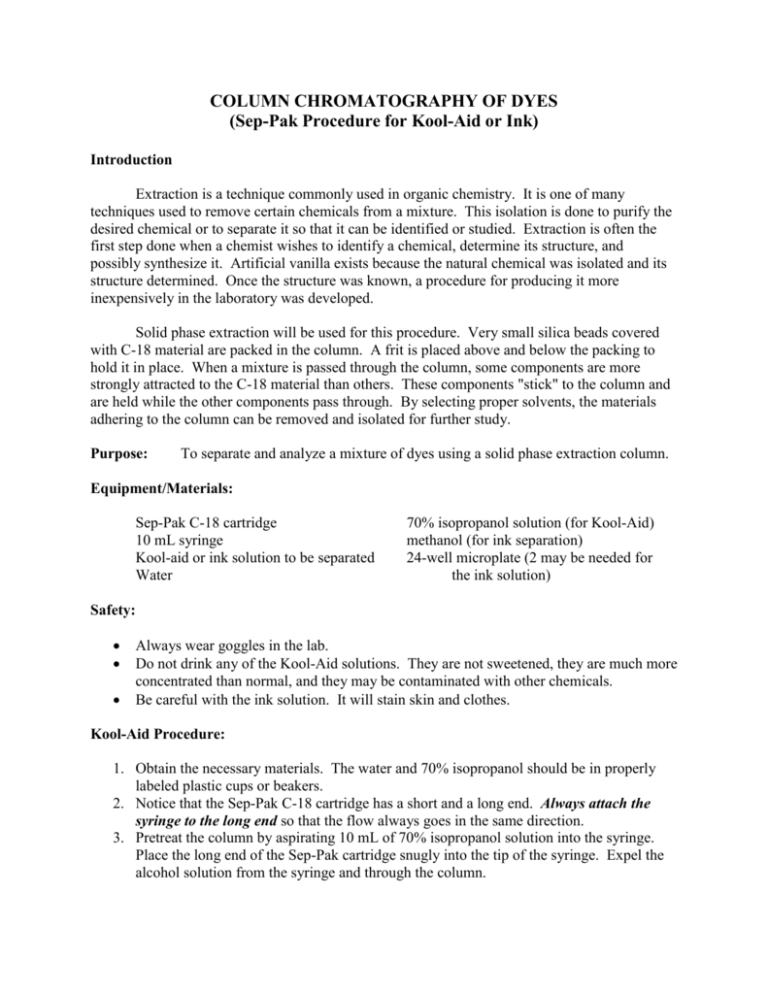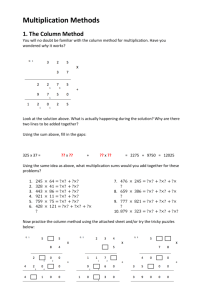COLUMN CHROMATOGRAPHY OF DYES
advertisement

COLUMN CHROMATOGRAPHY OF DYES (Sep-Pak Procedure for Kool-Aid or Ink) Introduction Extraction is a technique commonly used in organic chemistry. It is one of many techniques used to remove certain chemicals from a mixture. This isolation is done to purify the desired chemical or to separate it so that it can be identified or studied. Extraction is often the first step done when a chemist wishes to identify a chemical, determine its structure, and possibly synthesize it. Artificial vanilla exists because the natural chemical was isolated and its structure determined. Once the structure was known, a procedure for producing it more inexpensively in the laboratory was developed. Solid phase extraction will be used for this procedure. Very small silica beads covered with C-18 material are packed in the column. A frit is placed above and below the packing to hold it in place. When a mixture is passed through the column, some components are more strongly attracted to the C-18 material than others. These components "stick" to the column and are held while the other components pass through. By selecting proper solvents, the materials adhering to the column can be removed and isolated for further study. Purpose: To separate and analyze a mixture of dyes using a solid phase extraction column. Equipment/Materials: Sep-Pak C-18 cartridge 10 mL syringe Kool-aid or ink solution to be separated Water 70% isopropanol solution (for Kool-Aid) methanol (for ink separation) 24-well microplate (2 may be needed for the ink solution) Safety: Always wear goggles in the lab. Do not drink any of the Kool-Aid solutions. They are not sweetened, they are much more concentrated than normal, and they may be contaminated with other chemicals. Be careful with the ink solution. It will stain skin and clothes. Kool-Aid Procedure: 1. Obtain the necessary materials. The water and 70% isopropanol should be in properly labeled plastic cups or beakers. 2. Notice that the Sep-Pak C-18 cartridge has a short and a long end. Always attach the syringe to the long end so that the flow always goes in the same direction. 3. Pretreat the column by aspirating 10 mL of 70% isopropanol solution into the syringe. Place the long end of the Sep-Pak cartridge snugly into the tip of the syringe. Expel the alcohol solution from the syringe and through the column. 4. Remove the cartridge from the syringe and fill the syringe with 10 mL of water. Replace the long end of the cartridge snugly into the tip of the syringe. Expel the water out of the syringe and through the column. 5. Remove the cartridge from the syringe and fill with 10 mL of the Kool-Aid. Replace the long end of the cartridge snugly into the tip of the syringe and expel the solution out of the syringe and through the column. This time collect the effluent (the liquid that comes through the column) into the first column of wells of the 24-well microplate. (NOTE: All of the effluent will not fit into one well so use as many as necessary.) Describe the appearance of the effluent and the Sep-Pak column in your Data Table. 6. Remove the cartridge from the syringe and fill the syringe with 10 mL of water. Replace the long end of the cartridge snugly into the tip of the syringe. Expel the water out of the syringe and through the column. Collect the effluent into another column of wells of the 24-well microplate. Describe the appearance of the effluent and the Sep-Pak column in your Data Table. 7. Remove the cartridge from the syringe. Aspirate about 0.7 mL of the 70% isopropanol into the syringe. Aspirate water into the same syringe up to the 10 mL mark. This will make approximately a 5% alcohol solution. Invert the syringe several times to ensure that the solution is well mixed. Replace the long end of the cartridge snugly into the tip of the syringe and expel the solution from the syringe and through the column. Collect the effluent in another column of wells of the 24-well microplate. Describe the appearance of the effluent and the Sep-Pak column in your Data Table. 8. Repeat Step 7 using 1.4 mL of 70% isopropanol and water to the 10 mL mark. This yields a 10% alcohol solution. Collect the effluent in another column of wells of the 24well microplate and describe the appearance of the effluent and the Sep-Pak column in your Data Table. 9. Repeat Step 7 using 3.6 mL of 70% isopropanol and water to the 10 mL mark. This yields a 25% alcohol solution. Collect the effluent in another column of wells of the 24well microplate and describe the appearance of the effluent and the Sep-Pak column in your Data Table. 10. Repeat Step 7 using 7.1 mL of 70% isopropanol and water to the 10 mL mark. This yields a 50% alcohol solution. Collect the effluent in another column of wells of the 24well microplate and describe the appearance of the effluent and the Sep-Pak column in your Data Table. 11. Repeat Step 7 using a full 10.0 mL of 70% isopropanol. Collect the effluent in another column of wells of the 24-well microplate and describe the appearance of the effluent and the Sep-Pak column in your Data Table. 12. To clean the Sep-Pak C-18 cartridge for future use, clean the column with 10 mL of 70% isopropanol until it appears that all traces of dye have been removed. Then rinse the column with 10 mL of water. Ink Procedure: 1. Obtain the necessary materials. The water and methanol should be in properly labeled plastic cups or beakers. 2. Notice that the Sep-Pak C-18 cartridge has a short and a long end. Always attach the syringe to the long end so that the flow always goes in the same direction. 3. Pretreat the column by aspirating 10 mL of methanol into the syringe. Place the long end of the Sep-Pak cartridge snugly into the tip of the syringe. Expel the alcohol solution from the syringe and through the column. 4. Remove the cartridge from the syringe and fill the syringe with 10 mL of water. Replace the long end of the cartridge snugly into the tip of the syringe. Expel the water out of the syringe and through the column. 5. Remove the cartridge from the syringe and fill with 10 mL of the ink solution to be separated. Replace the long end of the cartridge snugly into the tip of the syringe and expel the solution out of the syringe and through the column. This time collect the effluent (the liquid that comes through the column) into one column of wells of the 24well microplate. (NOTE: All of the liquid will not fit into one well so use as many wells as necessary.) Describe the appearance of the effluent and the Sep-Pak column in your Data Table. 6. Remove the cartridge from the syringe and fill the syringe with 10 mL of water. Replace the long end of the cartridge snugly into the tip of the syringe. Expel the water out of the syringe and through the column. Collect the effluent into another column of wells of the 24-well microplate. Describe the appearance of the effluent and the Sep-Pak column in your Data Table. 7. Remove the cartridge from the syringe. Aspirate about 0.5 mL of the methanol into the syringe. Aspirate water into the same syringe up to the 10 mL mark. This will make approximately a 5% alcohol solution. Invert the syringe several times to ensure that the solution is well mixed. Replace the long end of the cartridge snugly into the tip of the syringe and expel the solution from the syringe and through the column. Collect the effluent in another column of wells of the 24-well microplate. Describe the appearance of the effluent and the Sep-Pak column in your Data Table. 8. Repeat Step 7 using 1.0 mL of methanol and water to the 10 mL mark. This yields a 10% alcohol solution. Collect the effluent in another column of wells of the 24-well microplate and describe the appearance of the effluent and the Sep-Pak column in your Data Table. 9. Repeat Step 7 using 2.5 mL of methanol and water to the 10 mL mark. This yields a 25% alcohol solution. Collect the effluent in another column of wells of the 24-well microplate and describe the appearance of the effluent and the Sep-Pak column in your Data Table. 10. Repeat Step 7 using 5.0 mL of methanol) and water to the 10 mL mark. This yields a 50% alcohol solution. Collect the effluent in another column of wells of the 24-well microplate and describe the appearance of the effluent and the Sep-Pak column in your Data Table. 11. Repeat Step 7 using 7.0 mL of methanol and water to the 10 mL mark. This yields a 70% alcohol solution. Collect the effluent in another column of wells of the 24-well microplate and describe the appearance of the effluent and the Sep-Pak column in your Data Table. 12. To clean the Sep-Pak C-18 cartridge for future use, clean the column with 10 mL of methanols until it appears that all traces of dye have been removed. Then rinse the column with 10 mL of water. COLUMN CHROMATOGRAPHY OF DYES (Sep-Pak Procedure for Kool-Aid or Ink) Data Table Name: Date: Period/Group: Data Table: Record here the type of dye solution separated: Solution Added to Cartridge Dye Solution Description of Effluent Description of Column Water 5% Alcohol Solution 10% Alcohol Solution 25% Alcohol Solution 50% Alcohol Solution 70% Alcohol Solution Questions: 1. Which dye is present in highest concentration in your sample? 2. In your sample, which dye had the highest affinity (attraction) to the column? Explain. 3. If two different colors both came through using 10% alcohol, how would you change the extraction procedure to make these separate? COLUMN CHROMATOGRAPHY OF DYES (Sep-Pak Procedure for Kool-Aid or Ink) Pre-Lab Questions Name: Date: Period/Group: 1. What does “aspirate” mean? 2. What is an “effluent”? 3. What does “affinity” mean? 4. In this procedure, which end of the Sep-Pak column is attached to the syringe? 5. Is this a qualitative or a quantitative lab activity?








